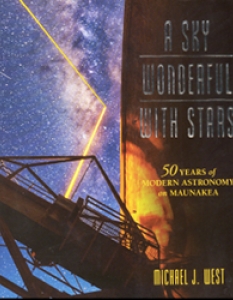These days, you expect any book on astronomy to be chock full of stunning colour images of the Universe and this one is no different… but it concentrates more on the hardware that produced those images than most. In this case it’s the telescopes sited 4200 m above sea level on Maunakea in Hawai’i.
The author is deputy director for science at Lowell Observatory in Flagstaff, Arizona, but his heart appears to reside on this Hawaiian shield volcano. The introductory section is spattered with poetic quotes and descriptions, alongside photographs from all angles (including from space) and in differing lighting conditions, to set the scene of what he calls “a place like no other”.
Following details of the founding of the observatory as a site, the author discusses the first telescope (an 88-inch/2.2m reflector) completed in 1970. Two years of “unusually harsh winter weather” delayed its construction and even getting the telescope’s computer control system – “it was new technology at the time”, reminds the author – took “several years of additional effort”. Among its contributions to astronomy was the discovery of the first object (designated QB1) in the Kuiper Belt at the edge of the Solar System in 1992.
Today, there are 13 facilities, including nine visible/IR telescopes, three submillimetre instruments and a radio telescope. The book also looks forward to the Thirty Metre Telescope (TMT) which, although officially approved in 2013, has been mired in protests by native Hawaiians who object to yet another telescope on their ‘sacred mountain’.
Anyone who likes astronomy will like this book, and there is even a small space technology element in mentioning the training of Apollo astronauts in the islands’ moonlike landscapes and, more recently, the testing of lunar sampling robots; a photo shows a strange, unidentified rover with internally sprung wheels and a body like a dodgem.
But perhaps the most unexpected photograph is one that shows the Hubble Space Telescope (as a time-lapse streak across a star field) with the domes of the Keck I and II telescopes on Mauna Kea in the foreground. There is something nicely inclusive about this image of a sky not only “wonderful with stars” but also wonderful with telescopes.
Mark Williamson











